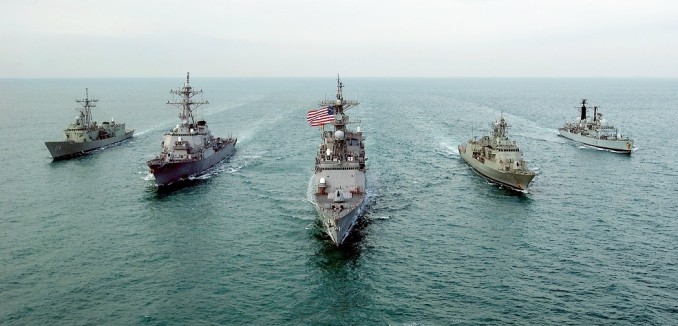A new propaganda video produced by Iran’s Organization of Islamic Information, which is controlled by Iranian Supreme Leader Ayatollah Ali Khamenei, portrays a group of Iranian men confronting and destroying an American naval fleet. A translation of the video was released by the Middle East Media Research Institute (MEMRI) on Tuesday.
The opening scene of the video, which shows a group of Iranian boys playing soccer on the beach, takes a dark turn when one of the children chases the ball into the water. A shadow covers the boy, who looks up to see a plane being shot down by American boats in the distance. A number of corpses fall onto the surface of the water soon after, promoting Iranian men on the land to spring into action. The U.S. ships approach the shore and start firing on the advancing men, who hold Iranian flags and sing, “If you step over me, I will break your legs into pieces.”
The Iranians emerge unscathed from the encounter and strike the shore with their flags, causing tidal waves to roll over and sink the American ships.
The video recalls the accidental downing of Iran Air flight 655 by the USS Vincennes in 1988. The Vincennes, which had been engaged in a shooting exchange with a number of smaller boats, saw the commercial flight approaching the area and mistook it for an attacking military fighter. When the plane didn’t respond to repeated radio calls, William Rogers, captain of the Vincennes, ordered the plane shot down. The U.S. paid over $60 million to Iran in 1996 as compensation for the 248 Iranians who were killed on the flight. Previously, the U.S. paid $40 million as compensation for the other 34 non-Iranian victims.
One of the boats destroyed in the propaganda video bears the name Vincennes.
MEMRI observed that the video was uploaded online twice in August: once on the pro-Khamenei website Javan, which is linked to the Islamic Revolutionary Guard Corps, and again on another pro-government site, which criticized the video for having a “weak” story-line and “[ignoring] Iran’s military capabilities.”
Iran has frequently threatened or targeted U.S. naval forces. Last September, Khamenei posted a video to his YouTube account which warned, “should any war break out, one who will emerge humiliated out of it will be invading and criminal America.”
The commander of the Islamic Revolutionary Guard Corps’ naval forces, Brig. Gen. Ali Fadavi, declared in May 2014 that his troops were simulating attacks on American aircraft carriers “because destroying, annihilating, and sinking US boats has and will be in our plans.” The following month, he warned the U.S. to leave the Persian Gulf, saying, “Americans removal from the Gulf is one of the basic tasks of the Iranian Revolutionary Guards,” and boasted that Iran could destroy the American fleet stationed there in 50 seconds.
In a February 2015 naval exercise, Iranian boats destroyed a replica of an American aircraft carrier. During the broadcast of the exercises on Iranian state television, a banner flashed across the screen with the quote, “If the Americans are ready to be buried at the bottom of the waters of the Persian Gulf – so be it.” The quote was attributed to the first leader of the Islamic Republic, Ayatollah Ruhollah Khomeini.
In January of this year, Iran seized two U.S. Navy boats and ten sailors after they entered Iranian territorial waters. Iranian Supreme Leader Ayatollah Ali Khamenei praised the Iranian troops who captured the sailors, saying that they did “God’s deed,” and subsequently gave medals to the commanders in charge of the capture.
There have been at least four incidents involving Iranian boats approaching U.S. ships in the Persian Gulf too closely or harassing them this month. The encounters were deemed violations of “international law and maritime standards” by the U.S. Navy. An American defense official quoted by Agence France-Presse said that there were 300 interaction between Iranian and American vessels in 2015, and 250 in just the first six months of 2016.
In ‘We Don’t Want to Forget’: In Tehran, Revenge Is a National Ethos, which was published in the June 2016 issue of The Tower Magazine, Annika Hernroth-Rothstein observed that hatred of the U.S. is “central” to Iran’s ethos, shaping “both its identity and its ideology.” Regarding the Vincennes incident, she wrote:
In July 1988, the commander of the American warship USS Vincennes made a decision that would prove disastrous. He sailed into Iranian waters in pursuit of Iranian gunboats, but ended up firing shots at a civilian airliner, killing 290 people. The Reagan administration’s attempts to handle the situation only exacerbated the problem. It released an official explanation that to many outside observers seemed implausible at best, and awarded the commander of the Vincennes a medal for bravery. Many Iranians believe to this day that the incident was not, as stated by the Reagan administration, an accident, but a deliberate act of aggression against Iran. The Vincenness candal was quickly followed by the Iran-Contra affair, and U.S.-Iran relations hit an all-time low. Iranians felt betrayed by the superpower, vowing to never again let America get close enough to hurt them.
[Photo: U.S. Navy / Wikimedia ]




